

This Element Could Have Made an Atom Bomb If Not for One Thing. Threads. Hairless_Talking_Ape comments on The nuclear test Operation Teapot's effects on houses. It's thousands of thermonuclear warheads at the very least dozens and sometimes hundreds of times more powerful than that atomic warhead, and would actually be closer to something like this explosion which will be fired off the tip of ICBM's from space and re-enter the atmosphere like meteors independently targeted at your nearest major military installation, nation/state/province capital, and major city Curious about what a nuke of any size would do in your area?
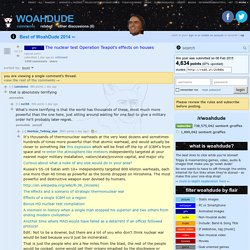
Russia's SS-18 Satan with 10+ independently targeted 800 kiloton warheads, each one more than 40 times as powerful as the bomb dropped on Hiroshima. The most powerful and destructive weapon ever devised by humans. The effects and a scenario of strategic thermonuclear war Effects of a single ICBM on a region Bonus HD nuclear test compilation A moment in history when a single man stopped his superior and two others from ending modern civilization Another time where MAD would have failed as a deterrent if an officer followed protocol. Manhattan Project. Two types of atomic bomb were developed during the war.
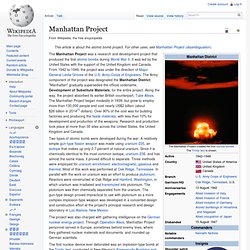
A relatively simple gun-type fission weapon was made using uranium-235, an isotope that makes up only 0.7 percent of natural uranium. Since it is chemically identical to the most common isotope, uranium-238, and has almost the same mass, it proved difficult to separate. Three methods were employed for uranium enrichment: electromagnetic, gaseous and thermal. Most of this work was performed at Oak Ridge, Tennessee. In parallel with the work on uranium was an effort to produce plutonium.
Castle Bravo. Castle Bravo was the code name given to the first United States test of a dry fuel, hydrogen bomb, detonated on March 1, 1954, at Bikini Atoll, Marshall Islands, as the first test of Operation Castle.
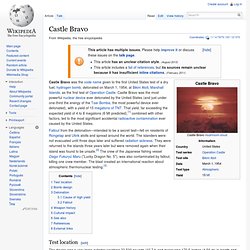
Castle Bravo was the most powerful nuclear device ever detonated by the United States (and just under one-third the energy of the Tsar Bomba, the most powerful device ever detonated), with a yield of 15 megatons of TNT. That yield, far exceeding the expected yield of 4 to 8 megatons (6 Mt predicted),[1] combined with other factors, led to the most significant accidental radioactive contamination ever caused by the United States. Fallout from the detonation—intended to be a secret test—fell on residents of Rongelap and Utirik atolls and spread around the world. The islanders were not evacuated until three days later and suffered radiation sickness.
Test location[edit] Gyokuon-hōsō. This article is about the radio broadcast of Emperor Shōwa's speech in 1945.
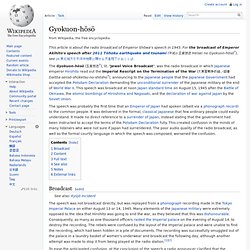
For the broadcast of Emperor Akihito's speech after 2011 Tōhoku earthquake and tsunami (平成の玉音放送, Heisei no Gyokuon-hōsō?) , see ja:東北地方太平洋沖地震に関する天皇陛下のおことば. The Gyokuon-hōsō (玉音放送?) , lit. Kyūjō Incident. The Kyūjō Incident (宮城事件, Kyūjō Jiken?)
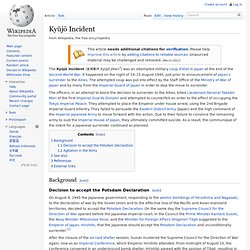
Was an attempted military coup d'état in Japan at the end of the Second World War. It happened on the night of 14–15 August 1945, just prior to announcement of Japan's surrender to the Allies. The attempted coup was put into effect by the Staff Office of the Ministry of War of Japan and by many from the Imperial Guard of Japan in order to stop the move to surrender. Background[edit] Surrender of Japan. Atomic bombings of Hiroshima and Nagasaki. In August 1945, during the final stage of the Second World War, the United States dropped atomic bombs on the Japanese cities of Hiroshima and Nagasaki.

The two bombings, which killed at least 129,000 people, remain the only use of nuclear weapons for warfare in human history. Background Pacific War Main article: Pacific War. LGM-25C Titan II. "Titan II" redirects here.
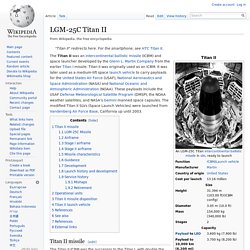
For the smartphone, see HTC Titan II. Titan-II ICBM silo test launch, Vandenberg Air Force Base Titan II launch vehicle launching Gemini 11 (September 12, 1966) Titan 23G launch vehicle (Sept. 5, 1988) Einstein–Szilárd letter. A copy of the letter The Einstein–Szilárd letter was a letter written by Leó Szilárd and signed by Albert Einstein that was sent to the United States President Franklin D.

Roosevelt on August 2, 1939. Though Szilárd consulted with his fellow Hungarian physicists Edward Teller and Eugene Wigner on it, he was the principal author. Unedited footage of the bombing of Nagasaki (silent) Trinity (nuclear test) Danegeld87 comments on How did cleanup in Nagasaki and Hiroshima proceed following the atom bombs? John von Neumann.
John von Neumann (/vɒn ˈnɔɪmən/; December 28, 1903 – February 8, 1957) was a Hungarian and later American pure and applied mathematician, physicist, inventor, polymath, and polyglot. Steel mill worker reveals blocking view of U.S. aircraft on day of Nagasaki atomic bombing. KITAKYUSHU, Fukuoka -- As the 69th anniversary of the Nagasaki atomic bombing approaches, a former mill worker in the present-day city of Kitakyushu, Fukuoka Prefecture, spoke about his untold story on how he burned coal tar to block the view of U.S. aircraft as they were about to drop the A-bomb on the city.
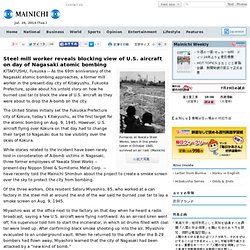
The United States initially set the Fukuoka Prefecture city of Kokura, today's Kitakyushu, as the first target for the atomic bombing on Aug. 9, 1945. However, U.S. aircraft flying over Kokura on that day had to change their target to Nagasaki due to low visibility over the skies of Kokura. Cuban missile crisis. The Cuban missile crisis — known as the October Crisis or The Missile Scare (Spanish: Crisis de octubre) in Cuba and the Caribbean Crisis (Russian: Карибский кризис, tr.
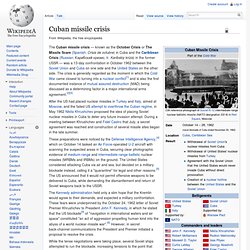
Karibskiy krizis) in the former USSR — was a 13-day confrontation in October 1962 between the Soviet Union and Cuba on one side and the United States on the other side. The crisis is generally regarded as the moment in which the Cold War came closest to turning into a nuclear conflict[1] and is also the first documented instance of mutual assured destruction (MAD) being discussed as a determining factor in a major international arms agreement.[2][3] After the US had placed nuclear missiles in Turkey and Italy, aimed at Moscow, and the failed US attempt to overthrow the Cuban regime, in May 1962 Nikita Khrushchev proposed the idea of placing Soviet nuclear missiles in Cuba to deter any future invasion attempt.
Able Archer 83. Able Archer 83 was a ten-day North Atlantic Treaty Organisation (NATO) command post exercise starting on November 2, 1983,[1][2] that spanned Western Europe, centered on the Supreme Headquarters Allied Powers Europe (SHAPE) Headquarters in Casteau, north of the city of Mons. Intermediate-Range Nuclear Forces Treaty. The Intermediate-Range Nuclear Forces Treaty (INF) is a 1987 agreement between the United States and the Soviet Union. Signed in Washington, D.C. by U.S. President Ronald Reagan and General Secretary Mikhail Gorbachev on 8 December 1987, it was ratified by the United States Senate on 27 May 1988 and came into force on 1 June of that year. The treaty is formally titled The Treaty Between the United States of America and the Union of Soviet Socialist Republics on the Elimination of Their Intermediate-Range and Shorter-Range Missiles.
The treaty eliminated nuclear and conventional ground-launched ballistic and cruise missiles with intermediate ranges, defined as between 500-5,500 km (300-3,400 miles). History[edit] Films: The Day After. Oddity Archive: Episode 21 - Protect & Survive. British Nuclear War from Beyond the Grave: The Letter of Last Resort. How To Fight Fire With Nuclear Bombs. Operation Plowshare: The Plan to Bomb America With Kindness. Wild Vegas parties celebrated atomic bomb tests of the 1950s. Two Physicists Wanted To Explode A Nuclear Bomb To Find Neutrinos.